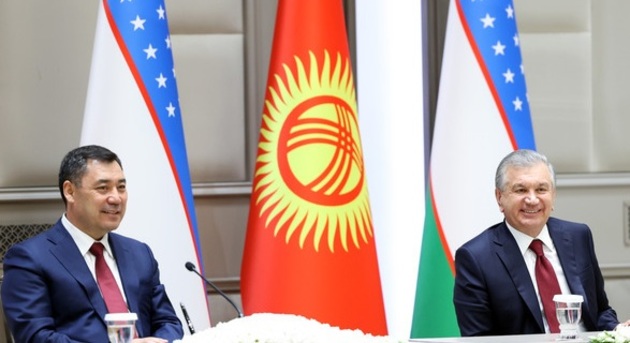At a meeting last week, March 11, the presidents of Kyrgyzstan and Uzbekistan, Sadyr Zhaparov and Shavkat Mirziyoyev, respectively, agreed to open land and air communications between Uzbekistan and the Uzbekistani exclave of Sokh inside Kyrgyzstan, The Jamestown Foundation writes. Additionally, they pledged to resolve their disagreement over the disputed Unkur-Too territory, which Tashkent had claimed even though Bishkek has long viewed it as a critical part of Kyrgyzstan because it is the site of a television transmission station that country needs.
Their accords, which promise to end this longstanding dispute and open the way to the completion of the demarcation of the border between them, were greeted with enthusiasm because they will allow for expanded trade not only between them but across Central Asia more generally
The sensitivity of this issue—along with an indication that more difficulties may lie ahead—was underscored, however, when senior Kyrgyzstani officials quickly and heatedly denied media reports Bishkek had conceded to “a corridor” between Uzbekistan and Sokh, where 40,000 plus ethnic Uzbeks live. Obviously, in this case, as in the one involving transit between Azerbaijan and Nakhchivan, the word “corridor” is a red line that cannot be crossed lest it provoke an explosion of nationalist anger in the country supposedly ceding territory. Transit is one thing, but a corridor is deemed something else.
That said, the agreement of the two presidents does suggest Kyrgyzstan and Uzbekistan will be able to complete the demarcation of the borders between them and preclude the kind of violence along their shared frontier that has been an all-too-regular feature there for years. Of the 1,378 kilometers of the border, 85 percent had been demarcated already by 2017 and another 10 percent agreed to but not formally demarcated. Now, the two leaders have committed their governments to reach an agreement on the remaining 5 percent in the next three months, something that seems possible and will allow for China to expand its rail network between and through both Central Asian neighbors.
At a minimum, the completion of this demarcation of the Kyrgyzstani-Uzbekistani border—assuming talks do not break down over the use of the term “corridor” or some other thorny issue—promises to prevent future clashes between residents living on both sides. Such violence has broken out repeatedly not just in the post-Soviet period but between the 1920s and the end of Soviet times. Even before 1991, borders mattered because they prevented easy access to water, transportation networks, and pastureland—restrictions that have only intensified for newly independent and nationally sensitive countries. Thus, the demarcation of this border will limit the ability of nationalists in both countries but especially in Kyrgyzstan to play up the issue for domestic reasons. At the same time, the resolution of the issues of access to Sokh and control of the Unkur-Too region marks another step on the way to putting in place borders in Central Asia acceptable to the governments and peoples of the region.
Exclaves and enclaves exist in many places around the world. But few regions feature a more complex pattern than does post-Soviet Central Asia. Of the countries in the region, only Turkmenistan lacks any at all. Kazakhstan has two in Uzbekistan but does not have any on its own territory. Tajikistan also lacks any inside its borders but has one in Uzbekistan and two in Kyrgyzstan. Uzbekistan has two Kazakhstani, one Kyrgyzstani and one Tajikistani enclave on its territory; while Kyrgyzstan has one exclave in Uzbekistan and, despite the new accord, still has three Uzbekistani and two Tajikistani enclaves within its borders. Solving each of these will be difficult, and each represents a potential flashpoint for the region.
Two Central Asian scholars have devoted extensive articles to these enclaves/exclaves: Salamat Alamanov, who focuses on their history (“Enclaves of Central Asia,” Post-Sovetskiye Issledovaniya, 2018, pp. 451-460), and Tatyana Zvergintseva, who has examined the current state of play about them (“Borders without Friendship: Why Enclaves Have Become a Headache for the Countries of Central Asia”). Both point to three possible variants for the resolution of these non-contiguous areas: an exchange of territory, the creation of corridors from the borders to them, and a special regime governing border areas. Zvergintseva, for her part, is skeptical about all of these: “An exchange of territories works and then only with great difficulties regarding small enclaves.” Creating territories also requires major efforts and expense. And establishing a special border region regime works only if the two countries involved are both willing to allow it.
But the existence of such a regime “strongly depends on relations between the countries, on the significance of the nationality question and on a common legal culture,” she continues. In many cases, countries prefer to retain the current situation to put pressure on their neighbors or to mobilize their populations about a threat to their nations. And there is another problem many prefer not to talk about, Zvergintseva suggests. If borders are kept relatively open, that allows for the freer flow not only of people and goods but of criminal elements and radical Islamists from one country to another—a challenge that all four of the Central Asian states with enclaves and/or exclaves face.
Nonetheless the accord between Bishkek and Tashkent shows that progress is possible, especially when the governments involved want to avoid the kind of clashes that can prove destabilizing and also seek to take advantage of new transportation routes that will open the way for greater economic development.






